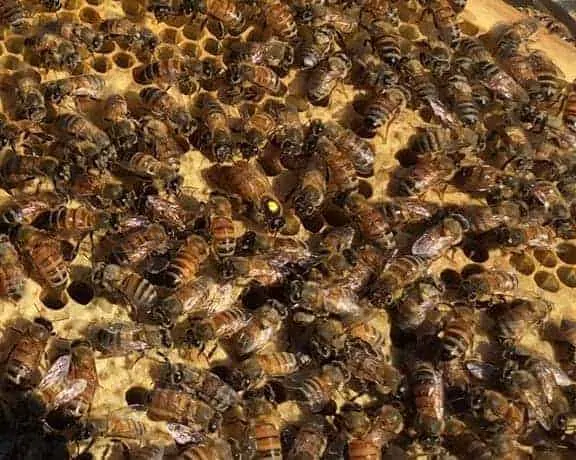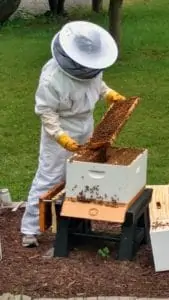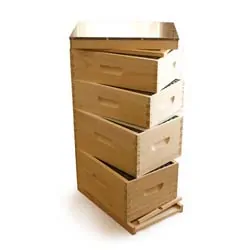Last week, we resolved a number of mysteries that had developed in my bee yard. It is hard to believe that I have been beekeeping now for over two months. Where has the time gone?
I am truly enjoying the time spent with my tens of thousands of working ladies. With that said, I can tell you that summer in western North Carolina is both hot and humid. Add to that mixture clothing under a full body bee suit and you have the making for one hot, sweaty, and exhausted beekeeper at the end of each inspection.
This week we are going to talk about both hive inspections and the importance of good record keeping. But, before we launch into our focal topic of the week, let’s talk about what happened in the bee yard this week.
Hive Updates
Hive Acquitaine
I have worried over this small hive that got its start as a split, from Hive Olympus, for weeks and weeks. I have reported steady, if not spectacular, improvements in this colony since I first installed it in the nuc. But, this week I finally feel like Eleanor has started building up some positive momentum!
Even though we shouldn’t, you know, fellow beekeeper, that we fret over our weaker colonies. But this week Eleanor sent me clear messages to stop wringing my hands. During this inspection, I noted that the population in this colony has bulked up a bit in the past week. This is probably from the emergence of new young brood, along with the infusion of brood and bees I added to the hive two weeks ago from Hive Florence.
The colony has finally begun to draw comb on an additional frame and has been storing both honey and pollen. But, the best discovery of this inspection was that Eleanor is finally getting her groove on!
In just one week, she has filled a couple of frames with new eggs. And, one whole frame was full of larvae in all instar stages of development. This was a welcome discovery for sure.
Since I will be in Portland, Oregon, for ten days, I will get to see what happens in a longer stretch of time. I bet I am going to find amazing growth when I return.
Hive Olympus
Hive Olympus has had a population explosion in the past month. Hecate has doubled and possibly even tripled the population in this hive since her introduction. There were bees on top of bees on all the frames. It is exciting to see what was once my weakest hive actually overtake all the other colonies in the bee yard. Carniolan queens are incredible production factories!
For the third week in a row, I didn’t find my beautiful lady. Yes, I’m worrying again! But, I did find tons of newly laid eggs, so she is there.
I had to do this inspection late in the day which made the bees a little more irritable, but we had no repeats of the beepocolypse of a few weeks ago! They had managed to drain the top hive feeder again but I decided to remove it and replace it with a new honey super.
The colony has now drawn comb on all ten frames of the medium box. Much of that work has taken place in the last week. Hecate managed to put a small amount of brood in the medium box but the workers have mostly filled it with honey.
The brood pattern in this hive remains an impressive sight with wall-to-wall capped brood. No wonder this hive’s population is exploding!
Last week I saw queen cells forming, but no occupants. During the week, they capped a small queen cup. Since Hive Florence taught me a good lesson, I took immediate action and moved the frame into the nuc box.
I added one frame of mostly brood with tons of nurse bees. And, to support the colony, I also added a frame with significant honey stores and two blank frames. I also shook some additional workers into the colony to give it a solid start and also placed the top hive feeder on the hive and filled it with my sugar syrup (sugar and water in 1:1 ratio with Honey B Healthy, Super Plus, Vitamin B Plus, and Amino Booster).
I am attempting to locate a mated queen to introduce into this nuc. The capped queen cup is really a paltry example, which I would prefer replacing with a heathy queen. Then, if Hive Florence has not produced a queen, I can combine the nuc back with that hive to re-queen it.
Hive Florence
Last week, I discovered that Hive Florence was queenless. During that inspection I discovered three queen cups and one uncapped cup. The queens have all emerged from the three cups. But I did not find a single one of them.
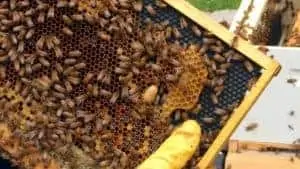
That could be because I don’t know what an unrated queen looks like. There were no eggs and larvae and a diminishing amount of capped brood. But, the colony was in the process of raising more queens. The other capped queen cup offered a surprise for me!
As I began examining the frame, I noticed that the queen was emerging. I left all the existing uncapped cups and the emerged queen. Since bees have been performing this process for eons, I decided to just step back and let nature takes its course. If there is no established queen when I return from my ten day trip, I will purchase a queen and re-queen the colony. After all, there is at least one more capped queen cup and another beautiful cup close to being capped. I will try to wait patiently to see what develops.
For the period of my trip, I am leaving the nucleus colony unnamed as it may serve as a colony to reunite with Hive Florence, should they remain queenless. So, from two colonies, I have the potential to growing to four colonies of bees.
Egads, I think the little devils are trying to work their keeper to the bone!
Hive Inspections and Recordkeeping
Regular hive inspections are integral to long-term success as a beekeeper. But, as a new beekeeper, it seems overwhelming at first that you’re supposed to process so much information while looking at thousands of busy worker bees.
So what should you be looking for when you perform an inspection? When I do an inspection, I am looking at five broad areas of data:
- General information about the hive
- Weather conditions during the inspection
- Conditions inside the hive
- Signs of disease or treatments applied
- Feeding and food stores available to the hive
Let’s explore each of these in more detail.
General Hive Information
I always note the date and time I began the inspection, so that I have a record of exactly when the last inspection took place. That can be key information if you are placing treatments in the hive as well. There are a number of key pieces of information that I am looking at as I work through the boxes in my hive including:
- Did I sight the queen?
- Is there capped brood in significant quantity?
- Is there uncapped brood?
- Are there multiple stages of uncapped brood present on the frames?
- Did I see eggs?
- If I found eggs, what are the orientations of the eggs?
- Do I see any cells with multiple eggs in them?
- What is the approximate weight of each box and the hive?
- Is the colony at full strength or at less than full strength (a percentage estimate from 0 to 100%)?
Did I sight the queen?
Let me just say right up front that you are not going to sight the queen every time you do an inspection. When your colony is at full strength, with 60,000 or more bees wandering the frames, you may not physically see her. One thing that will help you is to mark your queen. There is a color coded schema for marking queens that relies on the year you installed her in the hive. This year, queens should be marked with yellow.
I have one marked queen in one of my hives and I always find her because I know to look for that yellow dot on her back. But equally, I can normally find my Carniolan queen.
Do you have to sight the queen every time you perform inspections? Of course not! There are other points of data in your inspection that will tell you she is present without seeing her. But, I can say I always feel much better when I see her with a train of workers following along around her.
Is there capped brood in significant quantity?
Capped brood represent your immediate next generation of workers and drones. If you see very little capped brood, that could be a warning sign. You would want to file that piece of information away as you continue the inspection.
You need a steady supply of new workers to replenish the workers that wear themselves out. Remember, the life cycle of a summer honeybee worker is at most 6 weeks, as she will wear herself out in that time. So, if you lack plenty of capped brood, you need to put some other points of data together to know whether this is a serious issue or just a temporary lull.
Is there uncapped brood? Are there multiple stages of uncapped brood on the frames?
You should expect to find uncapped brood during your inspection. If uncapped brood are missing, you may again have an early warning sign of a problem with your queen. Larvae represent the natural progression of brood in the hive and make up part of the brood pattern that you should be examining. If at this point in your inspection you have found no capped brood (or very little capped brood) and no uncapped brood, you have a major warning sign which now requires you to find eggs!
In my inspections, I like to examine the stages of larvae. If I see larvae that are all very tiny, then I know that these are the first instage of larvae, whose egg casing has recently dissolved. That would tell me that I have lots of extremely young larvae.
What I really like to see when I am inspecting my hives is a combination of all stages. In my inspections, larvae of all stages have been present, including recently pupated workers.
Did I see eggs? If I found eggs, what is the orientation of the eggs?
If you do not find the queen, you want to look for eggs. The presence of eggs indicates that the queen is present and has been present within the last three days. If you examine the orientation of the eggs, you will learn how recently she laid these eggs. Newly laid eggs will be near vertical in the bottom of the cell. If you find eggs in this position, you know the queen was present within the last day.
Over the course of of the three days of incubation, the egg will move from vertical to nearly horizontal. As the third day ends, the egg casing will dissolve releasing the first instage larvae.
If, at this point in your inspection, you have found little or no capped brood, little or no larvae and no eggs you should consider your colony queenless. If you have very little capped brood as well as no brood in the production line, you have a colony in serious trouble. Workers need at least larvae that can be fed royal jelly, so they can raise a queen. If there are no eggs or larvae, you will need to re-queen the colony.
Do I see any cells with multiple eggs in them?
If you have found little to no brood, then you should be looking to see if there are any cells with multiple eggs in them. When you see multiple eggs in a cell, it typically indicates the presence of a laying worker.
When the critical queen pheromones dissipate, some workers ovaries will begin to develop, allowing them to lay unfertilized eggs. All of these eggs will result in drones. Since the workers do not have the long abdomen of the queen, nor do they have the control that the queen has in egglaying, they will deposit multiple eggs and they will be off-center.
If you allow a colony to go queenless for too long, it can become an unrecoverable condition due to large numbers of workers who begin laying.
What is the approximate weight of each box and the hive?
Estimating the weight of the hive gives you an idea of how large the honey stores are in preparation for winter. Bees will consume between 40 to 60 pounds of honey during the winter. Colder regions require heavier honey stores than warmer regions. There are hive scales that will measure the weight of the hive and send that information wirelessly to a phone app. These devices do not come cheap but do allow you to follow the increase in honey stores.
If you don’t want to spend the money on multiple scales for your hives (and I don’t!), you can effectively estimate the weight by paying attention to honey stores on frames. On average, a medium frame filled with honey weighs about 5 pounds. So a medium box with ten frames would contain about 50 pounds of honey. A deep frame filled with honey weighs about 10 pounds (and if you don’t believe that, just try and lift a deep frame that is filled with nothing but honey).
Estimating the weight of your hive will indicate very clearly when a honey flow is occurring.
Is the colony at full strength or at less than full strength (a percentage estimate from 0 to 100%)?
OK, OK, you’re guesstimating here but I am learning that with each inspection I am recognizing when a hive is truly heavily populated and when it is a bit on the light side of things. I make my best estimate here as to how close the hive is to 100% strength.
A colony at full strength contains around 60,000 bees. When a colony is at this size, there will be bees on top of bees and it is not uncommon to see moving clusters of bees. Hive Olympus is my one hive I consider at 100% (or very nearly 100%). I credit Hecate’s population explosion as part of the reason that I haven’t found her in two inspections, despite finding plenty of eggs. Even though this is an estimate, I believe you get better over time at having a sense when a colony is closer to full strength.
Weather Conditions During the Inspection
First off, you know you shouldn’t inspect when it is raining. Right?!? And, you also know you shouldn’t inspect if the temperature is in the 50s or below. Right?!? Just checking to make sure you hadn’t forgotten some important basics.
I do like to know some basics about the weather condition at the time of my inspection including:
- Temperature
- Humidity
- Wind Speed
- Barometric Pressure
All of this information I collect electronically based on the time of the inspection. So, as long as I know what time I started the inspection, I can collect this data after the actual inspection.
Eventually, I want to compare this data to see if weather conditions play any role in how my bees behave during the inspection. I suspect there may be a correlation between behavior and some weather conditions, but that is just a suspicion and not a proven fact.
Conditions Inside the Hive
There are a number of elements I look at concerning conditions inside the hive including:
- Hive Odor
- Equipment Condition
- Hive Condition
- The Presence of Queen Cells
- The Temper of the Hive
- The Population of the Hive
- The Brood Pattern
Hive Odor
One of the first thing you will note as a new beekeeper is that the hive has a very pleasant odor. It is one of the things I look forward to during inspections. Furthermore, I have learned that if I am downwind from the hives, I can smell the hive odor some distance from the bee yard. It always brings a smile to my face.
You should be taking a sniff of your hives when you’re performing inspections because your nose can be another tool in your arsenal to discover a problem.
Obviously, if the odor of the hive is foul, that indicates that something very bad is happening in the hive. A foul odor is a sign of American Foulbrood, one of the worst maladies that could affect your bees. If you smell an odor that has been described as the smell of rotting meat, you may have American Foulbrood and an examination of the brood will reveal it. Check out this Bee Informed article on American Foulbrood.
On the other hand, if you detect the scent of fermented honey, you should check for Small Hive Beetles as the larvae burrow through the comb eating the honey and brood and defecating in the honey, causing it to ferment. Honey can ferment in the absence of Small Hive Beetles but it is a less likely occurrence than the damage caused by the larvae of the Small Hive Beetle.
Equipment Condition
When you are performing inspections, you should be paying attention to the status of your boxes and the frames in the boxes. Over time, normal wear and tear will wear down the equipment and you need to be watching for damage that indicates you need to replace frames and or hive boxes.
Additionally, frames should be retired after three years of use in the brood boxes due to accumulated detritus from successive generations of larvae as well as buildup of chemicals from treatment in the wax. If equipment is in poor or damaged condition, replace it immediately.
Would you want to live in a home with a broken wall?
Hive Condition
There are many things to be looking for in the hive itself. Is there a build-up of burr comb? If so, you need to use your hive tool and remove it. You also need to check to see that your frames are properly positioned and observing bee space. Burr comb left unchecked can create a real mess in the hive. Clean it out as soon as you encounter it during your inspections.
Another thing you need to be watching is a build-up of excess propolis. My bees are expert propolis creators! As you work the frames, clean off excess build-up of propolis from the frame edges as well as along the box where you hang your frames. You know how sticky propolis is by now so, assist yourself with future inspections and clean it out as you go. Propolis is a commodity that you can sell so you might consider collecting it.
You should also be keeping an eye out for dead bees in the hive. That could be a sign of pesticide poisoning, robbing or a number of other things. If dead bees remain in the hive, then you probably want to be checking the hive thoroughly, as bees are fastidious creatures and will remove dead bees from the hive. If they stop doing that, you should probably be checking for disease conditions.
You also want to watch out for excess moisture in the hive. The hive may need additional ventilation to reduce a build-up of moisture inside the hive. Remember, the bees keep it fairly toasty inside their home which can create condensation and wet bees are not happy bees!
The Presence of Queen Cells
While performing inspections, you should always be looking for the appearance of queen cells. If you find queen cells, you need to perform a deeper inspection to determine the nature of the cell.
Any hive will build queen cells just to be ready for a potential occupant. They will also tear them down and rebuild them many times over. What you need to be paying attention to is whether that queen cell is occupied with an egg or larvae. Since a queen emerges within 16 days after the egg is laid, you don’t have much room for error with queen cells and cups.
The first thing to note is where the queen cell is positioned. Is it along bottom of the frame or is it in the middle of the frame? It matters a great deal since queen cups along the bottom of the frame indicate a colony that is about to swarm.
Once the queen cup is capped, you are out of time and need to perform an emergency split to stop the swarm. If the queen cup is in the middle of the frame, the colony is attempting to supersedure. That likely means that they sense something wrong with the queen and are making efforts to replace her. Trust your bees on this factor, they don’t create supersedure cells without reason.
The Temper of the Hive
Yes, bees do have a temperament and a temper to go along with it. How your bees react to you as you perform inspections reveals clues about the condition of the colony.
When the bees are calm, you know you have a queenright colony. I have experienced the difference between a queenright colony and a colony without a queen. If the bees are nervous, there could be a number of causes. They could have just lost their queen or even been disturbed during the night. You’ll need to investigate thoroughly to determine the cause of their nervous behavior.
If a colony goes an extended amount of time without a queen, they will begin to get angry. The only thing that will change their temperament is a queen. Also, sometimes we do things during our inspections that will change the temperament of the colony. But, be aware of the temper of the colony and use it as a clue or an indicator.
The Population of the Hive
The population in the hive is akin to the Hive Strength talked about earlier. Are the frames heavy with bees? Are the frames moderately filled with bees? Or do you have a diminishing population of bees? Paying attention to the population can help you understand how strong the colony is and whether or not you have a productive and healthy queen.
The Brood Pattern
You must pay close attention to the brood pattern in your hives. It tells you a lot about the quality and viability of your queen. You want to see a solid pattern of brood in the brood box.
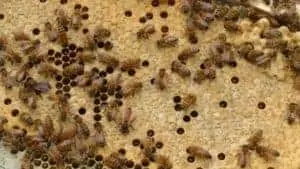
A healthy queen will fill a brood frame with brood in the center and the workers will put pollen and honey around the edges of the frame. If you examine the brood pattern, and it is spotty throughout all the frames, you likely have a failing queen and will need to take steps to re-queen the hive (that is if the colony doesn’t take it upon themselves to supersede the queen).
Learning to assess the brood pattern is an important skill to being a successful beekeeper. You should review this article on the brood pattern.
Signs of Disease or Treatments Applied
At a recent beekeepers club meeting, our region’s state inspector presented about the threat of the Varroa Mite. He addressed testing modalities as well as effective treatments. Lack of good record keeping was what he indicated as a primary problem for beekeepers in western NC. They didn’t have accurate records of when they tested for Varroa Mites and when and how they treated. It was a very effective presentation for this new beekeeper. During my inspections, I am actively looking for signs of disease. The primary pests that you need to be aware of include:
There are obviously other ailments that can affect your bees but the list above represents the most critical elements you need to be aware of when doing your inspections.
There are different treatments for each of these maladies. For instance, Varroa Mite treatments alone include Apiguard, Apistan, Mite-A-Thol, FormicPro, Apivar, HopGuard, Oxalic Acid, and Api-Life Var. You should read about the efficacy of each of these treatments and choose a treatment that is still effective and doesn’t show resistance.
The key to any treatment of any of the ailments is to read and follow the directions exactly, record when you place the treatment and when you removed the treatment. If you are treating for Varroa Mites, perform testing after you remove the treatment to see that it was effective.
Feeding and Food Stores Available to the Hive
During inspections, you also want to be aware of the food stores available to the colony. You should be assessing the amount of honey stores available to the colony.
As you approach winter, you want those honey stores to be on the high side of the equation to give them plenty of food for overwintering when in most parts of the country they cannot forage. You also want to be aware of the pollen stores as those are critical to feeding brood. If there isn’t enough pollen available, the queen will slow or even stop her production of eggs until the pollen supply is replenished.
If you are providing supplemental feeding, record what you are feeding including any supplements that are mixed into your feeds, so that you have a clear picture of how much and how often you are feeding the bees. It is helpful to keep track of this to see if your supplemental feeding is providing the colony the potential for quicker growth.
Record Keeping for Inspections
There are many methods you can employ for keeping records of your inspections. You can print inspection worksheets that you complete as you work your hive and then place them in a three ring binder for future reference. Or, you can try newer, electronic options for storing the records of your hive inspections. I decided when I started to use HiveTracks. It gives me a comprehensive tool that I can use to track my inspections, feedings, and observations of the hives.
The software also allows me to track each hive concerning whether there is a marked queen or an unmarked queen present as well as tracking the equipment used in the hive. It also provides an inventory of equipment in use and equipment in storage.
I have found it easy to use, easy to learn, and a value-added tool for my purposes. But, the key to record keeping is do what works for you. We aren’t all software consultants used to learning and using new software! But, I encourage you to do yourself a favor and keep records so that you have the ability to spot and explain trends in your data. For instance, in addition to HiveTracks, I keep a written journal of my observations of my hives.
Coming Next Week
As I will be traveling to Portland, Oregon, for an 11 day trip, I will be away from my bees this coming weekend, when I would normally perform an inspection. However, I still have some news that developed while I was writing this blog post. I’ll share that news with you as well as any word I get from home about how things are going. This coming week I will be offering another bee musings column so look out for some of my pithy humor!
Until next time, happy beekeeping!

